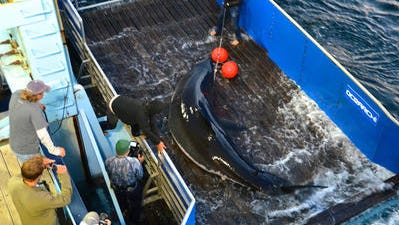Thanks for telling us where not to swim, Mary Lee Shark
 Andrew Sharp
Andrew Sharp

You’ll be thrilled to learn that Mary Lee Shark, the 16-foot, 3,500-pound toothy Twitter star, is again cruising the waters off Delmarva. The farther you are from the beach, the more excited you probably are.
Mary Lee, a great white, and other tagged sharks periodically make their appearance in these waters to touch base with their local Twitter fans and catch some of the local cuisine. We know this thanks to OCEARCH, a nonprofit that researches sharks and tagged Mary Lee in 2012.
Through the work of OCEARCH, we can learn more about these apex predators of the ocean, which are an important part of the ecosystem, because they help keep the populations of fish and tourists at sustainable levels.
I’m kidding, kind of. Sharks are actually mostly harmless, unless they mistake you for a seal or simply decide they’re in the mood for something new. Still, as you try to swim to shore with bleeding stumps where your legs used to be, you can comfort yourself with the knowledge that this kind of thing is really very rare.
Until we started tagging sharks, it was easier to pretend that they were somewhere else, maybe snacking on sailors around a shipwreck in the South Pacific, or cruising some coral reef in the Caribbean. OCEARCH shattered that little fantasy.
READ MORE:Just in time for beach season, great white returns to Delmarva
For those who aren’t on Twitter, there was also the big dispute last summer over Ocean City clamping down on fishing for large sharks from the beach, another handy reminder that it’s not just dolphins swimming around out there just offshore. Care to rent a paddleboard or a kayak this summer? I hear prices are really dropping.
The thing OCEARCH overlooked with their genius Twitter campaign was that there are some things it’s simply better not to know. Next thing you know, they’ll be tagging snakes and spiders.
That would be great for the newspaper, since we could write lots more articles about tweeting animals, but this member of the staff would be far less enthusiastic. Spiders don’t bother me much, but I definitely do not want to read an article about how Fred the Tweeting Black Rat Snake is now residing in the ceiling of my garage.
Snakes and I get along fine as long as we can live in mutual happy ignorance of each other. Then I’ll spot one slithering through the yard or disappearing into a shed, and I live on high alert for a few days, scanning the nearby terrain for signs of serpents. And I burn down the shed, of course.
MORE OPINION:Remember history by removing Confederate statues
Once I don’t see it for a while, I gradually am able to convince myself that it died in the shed fire, or moved away to some other place that I am not likely to go, such as outside my house.
A fact I do not want to confront is that snakes actually do exist, and that the ones I see are probably not just passing through, but longtime neighbors.
It’s why Alaska ranks pretty high on my list of great places to live. Sure, you live in darkness buried under snow and ice, and it can be hard to find basic foodstuffs, but there are, as I understand it, no snakes.
I’ve never felt the same way about sharks that I do about snakes. But when I do happen to find myself bobbing in the water on the edge of the murky depths of the Atlantic Ocean, my thoughts sometimes flicker to what might be lurking in the water under my flailing toes.
Thanks to OCEARCH, now I know.
Email Andrew Sharp at asharp@delmarvanow.com. Find him on Twitter @buckeye_201 and on Facebook @andrewsharp201.